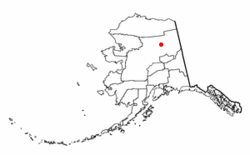2020 Census
As of the 2020 Census, [3] there were a reported 48 inhabitants across 41 households and 57 housing units within the CDP. The population density was 2.34 inhabitants per square mile (0.90 inhabitants/km2). The racial makeup was 95.83% Native American, 2.08% White, and 2.08% Hispanic or Latino.
The median household income was $36,964 and the median incomes for families was $46,250, both of which remained far below the Alaska median household income of $88,121. The poverty rate was 26.2%, including 61.1% of people under 18 years old and 24.4% of those aged 18 to 64 years.
The employment rate was 72.7%, with 70.8% of workers being in local, state, or federal employees, 22.9% being employees of private companies, and 6.3% being employed by private not-for-profits. As for transportation, 100% of workers 16 years old and over walked to work, with the average commute time being 5.6 minutes.
2000 Census
As of the census [8] of 2000, there were 84 people, 31 households, and 19 families residing in the CDP. The population density was 4.1 inhabitants per square mile (1.6/km2). There were 54 housing units at an average density of 2.6 units per square mile (1.0 units/km2). The racial makeup of the CDP was 4.76% White, 85.71% Native American, and 9.52% from two or more races.
There were 31 households, out of which 41.9% had children under the age of 18 living with them, 12.9% were married couples living together, 32.3% had a female householder with no husband present, and 38.7% were non-families. 29.0% of all households were made up of individuals, and 6.5% had someone living alone who was 65 years of age or older. The average household size was 2.71 and the average family size was 3.42.
In the CDP, the population was spread out, with 40.5% under the age of 18, 4.8% from 18 to 24, 32.1% from 25 to 44, 15.5% from 45 to 64, and 7.1% who were 65 years of age or older. The median age was 29 years. For every 100 females, there were 154.5 males. For every 100 females age 18 and over, there were 163.2 males.
The median income for a household in the CDP was $28,750, and the median income for a family was $29,792. Males had a median income of $26,667 versus $16,875 for females. The per capita income for the CDP was $8,441. There were no families and 11.1% of the population living below the poverty line, including no under eighteens and none of those over 64.



